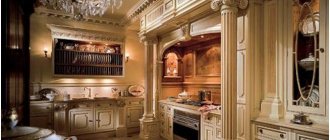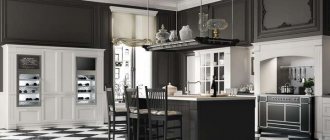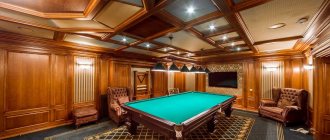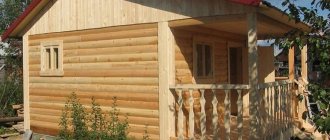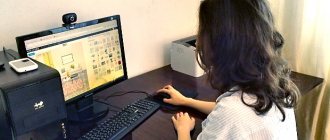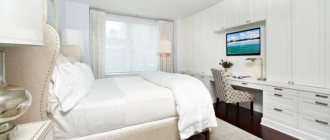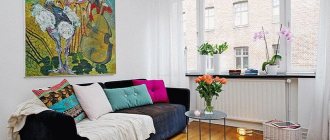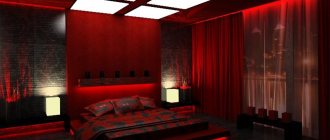Classic, baroque, modern, minimalism - in any style you should follow the basic rules for constructing a living space, one for everyone. They come from the psychology of human perception of information. And, like the laws of nature, they remain unchanged and omnipresent.
The influence of the environment cannot be overestimated. Our state of mind and even health directly depend on this. A person who lives in the right, comfortable environment can be immediately distinguished from a thousand. He walks down the street and feels good. Riding the subway, sitting at work, the first thing you can see in this is that the person feels good. He has time to “charge” himself at home for the whole day. Why is he like this? You will immediately understand this if you visit. It's so good there that it takes your breath away. Walls, floor, ceiling - everything is as usual. If separately. And together the entire interior fills the soul with wonderful feelings.
Let's study. Create beauty. And live beautifully.
Golden ratio rule
When we look at a picture, or at the wall of a room, the information is first processed by the right hemisphere, the “technical” one. For multiple and clear proportions, repetition of identical elements. Then, if the right does not find anything interesting for itself, the left, the “humanitarian”, enters. It is responsible for the associative series, fantasy, and other lyrics. If an artist paints the most beautiful landscape in the world, but the horizon line in the picture divides it exactly in half, no one will simply see this beauty. The viewer’s brain will not perceive any beauty, because the “humanitarian” hemisphere will not even “turn on”.
The golden ratio rule states: no even or multiple divisions. Only asymmetry and irrationality. Do you need to combine two colors of wallpaper on the walls a third of the way up? Measure out a third and a little more.
Psychology of visual information perception
Let’s take things and phenomena from the very thick of everyday life “bone by bone.” Whether you like the picture or not. Convenient, cozy in the room or not so much. Only the result enters consciousness, while the head does a really great job of analytical work.
When looking at a painting, we run our gaze from the upper left corner to the lower right. Always. With no exceptions. Right-handed and left-handed. Then we begin to wander around the picture with our eyes, stopping first simply at the bright spots, and then at the elements that carry a semantic load.
Let's look at how the head works using geometric shapes as an example.
Arabs read from the lower right corner to the upper left. And their entire perception of visual information occurs exactly the opposite. Just imagine - there are people living next to us who perceive the world literally inside out. I keep thinking - maybe it’s the same in their music? Do these languid, mournful minor songs invigorate them?
Here the large square “hangs” over the ball. It's like it's about to crush you. The round, soft shape and smaller size of the ball associate it with small and good. The angular square here is “evil”, dangerous.
And here the ball “floats”, as if flying away from the square. The square now gives us a feeling of confidence, solidity, peace.
The relationships between these geometric primitives can be quite dramatic. Depending on their position, the image of a square and a circle acquires any emotional sound.
And all because we look at the picture from the upper left corner to the lower right, and we perceive the figures in turn, which means in time, which means in action.
Major-minor
We all know very well what it is. We just can’t explain it. What means can you use to express emotional coloring in the interior? First of all - color. Cold ones are minor. Warm - major. And by combining the colors of individual elements, like an orchestra, we express deep and rich emotional states.
An equally important carrier of emotions is form.
In a minor key painting, the horizon line ALWAYS descends from top to bottom.
Major - the horizon line rises.
Shape and color are inextricably linked. If in painting artists subconsciously use all these techniques to express their emotional and mental state, then in the interior we reasonably limit the emotional components. Imagine an environment that constantly stimulates laughter. I can’t help but remember the joke about a girl who had a brick fall on her head at a construction site. She just laughed. He still walks like that - laughs.
And also, using these expressive means, we can fill the interior with rich, rich taste. Or, for gourmets, on the contrary - sophisticated.
I am begging you. Do not start renovating until you have thought through the entire project, right down to the furniture. Finalize the color of the floor or walls after you choose cabinet furniture and the colors of the upholstery on the sofas. Kitchen. Let the preparatory stage drag on a little. But everything will work out well. I confess to you that I myself made a mistake, which I now warn you against. In the fall I renovated my apartment in a modern style. In the living room I decided to use a solution like “Invisible Furniture”. I suggested light fronts on the cabinets. I bought wallpaper there in the color “natural linen”. The time came to order furniture - and I realized with horror that if I hung light-colored facades, the whole room would become too white. Boring. I currently live with furniture without doors. I'm thinking what to do. I probably use doors in the color “bleached oak”. It's almost no different from my wallpaper. The result will truly be “invisible” furniture. “Sits” on the walls like a glove. So it goes. And how many cases have we had when clients still applied new wallpaper after purchasing furniture!
Roles and responsibilities of interior design specialists
It should be remembered that an interior designer does not just choose the color of the walls and the arrangement of furniture. His task is not only to create a new unique space with an individual style and atmosphere, but also to transfer his idea to sketches, drawings and 3-D layouts, to correctly assign tasks to builders and finishers and monitor their implementation at every stage.
The job responsibilities of an interior design specialist who is a hired employee of a design studio or architectural bureau most often include the following:
- creation of interior design projects for residential, commercial and public premises;
- determining the general stylistic direction and concept for the design of the room;
- coordination with clients of the concept and details of design projects;
- 3D visualization and development of drawings for interior design projects;
- calculation of the required volume of purchases and consumption of construction and finishing materials;
- advisory participation or independent purchase of construction and finishing materials, furniture, lighting and decor;
- if necessary, creating concepts and sketches of original furniture models for design projects, transferring them to production;
- designer's supervision during construction and finishing works;
- room decor;
- participation in professional exhibitions.
Designers who are not employees and carry out orders on a self-employment basis, are registered individual entrepreneurs, or are planning to open their own design studio, can be guided by this job description to regulate and streamline their own activities and the work of the team.
The most common requirements of employers for applicants for the position of interior designer
Level of beginner designers or designers for the economy/middle segment:
- Higher/incomplete higher education;
- Experience as a designer from 1 year;
- Confident PC user (MS Office, AutoCAD, 3DS Max, ArchiCAD, etc.);
- Knowledge of the theoretical foundations of interior design;
- Knowledge of the main stylistic and thematic trends in the interior, understanding of the principles of their combination and implementation.
- Spatial thinking;
- Developed communication and negotiation skills;
- Computer design skills;
- Knowledge of modern fashion trends in interior design;
- Having your own portfolio of developed and implemented design projects;
- Ability to navigate the market of modern construction and finishing materials, knowledge of the range and main manufacturers;
Possible wishes: having a car, speaking/fluent English
Professional/Premium level (all of the above, plus):
- Experience as an interior designer from 3-6 years;
- Experience in implementing design projects for large premises/country houses
- Experience in design/implementation of interior design projects with complex technical equipment;
- Experience in independent development and implementation of large-budget design projects.
The non-decorative role of painting in the interior
The work of a true artist, not a craftsman, works wonders. You can just look at another picture in the morning instead of exercising. And that’s it - I’m already awake and ready for labor feats. Why is this happening? We will not go into parapsychological implications and any unprovable mysticism. You encounter another manifestation of this mysterious energy many times every day. This is the "sense of looking." Look at the back of a passerby on the street. Or a companion on the subway. The man will turn around. And you, without noticing it, respond to other people’s eyes a hundred times a day.
These are the main rules. Even though we only skimmed the top, galloping across Europe, you already got the general idea. We will return to this topic more than once. If our reasoning really interested you, then you will certainly be interested in Wassily Kandinsky’s book “On the Spiritual in Art” (electronic version of the book here >>) This is one of the few programmatic works on the theory of painting. It is no longer possible to find it in paper form.
Article provided by Kombinator.ru.
Top 10 online courses
This selection includes the most popular courses from well-known online universities and schools. There are in-depth long-term and narrowly focused capacious programs, it all depends on what goal you set for yourself. Read the brief description, if anything interests you, follow the link to the course page.
24.04.2020
277
30 Best Design Courses from Scratch
A selection of courses on teaching different types of design. We have collected the best free and paid materials for beginners and professionals.
“Profession Interior Designer” from Skillbox
The profession of Interior Designer is a large program for training specialists at the Skillbox online university. Duration of training – 12 months.
During this time you:
- Immerse yourself in the profession, learn to identify client needs and develop a concept;
- work in ArchiCAD, master the construction of drawings and visualizations in three-dimensional space;
- learn how to make beautiful layouts in 3ds Max;
- learn how to refine visualizations in Photoshop;
- learn to create a team and work together on projects;
- you will do 4 works for your portfolio.
Benefits of the course:
- A great program for mastering a profession from scratch.
- Assistance in further employment.
- 6 offline meetings with specialists.
- Practicing teachers.
- Possibility of obtaining a loan for education.
The cost of the course at the moment is 120,900 rubles.
“Interior design from 0 to PRO” from Skillbox
Interior Design 0 to PRO is another one-year training program for aspiring designers from Skillbox.
Knowledge and skills you will gain:
- working with clients, receiving a clear assignment;
- work on the project from technical specifications to implementation;
- measurements, planning and redevelopment;
- legislation and regulations;
- modern finishing materials;
- creating a budget for the project;
- work with Photoshop, ArchiCAD, 3ds Max programs.
During your studies, you will create designs for one- and three-room apartments and houses, which will form the basis of your portfolio.
Advantages:
- Lots of practice.
- Modern knowledge about materials and trends.
- Practicing designers and teachers.
- Skills in working with clients: from receiving a clear assignment to delivery of the project.
The cost of the program currently is 79,000 rubles.
“Interior Design” from GeekUniversity
Interior design is a 12-month course from the GeekUniversity online university. There are 2-3 lectures per week, which you need to have time to watch and practice. Each quarter of the class is assigned to a different project group to complete a final assignment.
Each student is assigned a curator who answers all questions and advises on practical work. By the end of the training you will have 4 ready-made projects for your portfolio.
What you will learn:
- modeling the future space of an apartment or house;
- drafting;
- proper zoning of rooms;
- working with other people from related professions;
- interaction with the customer;
- calculation of estimates and budgets.
Advantages:
- Diploma of professional retraining.
- Help with employment.
- Work independently and in a team.
- You can apply for a bank installment plan without overpayments.
The cost of training at the moment is 9,166 rubles. per month.
“Online course on interior design” from hedu
Online course in interior design - an accelerated program from the hedu school, lasting 3 months. It can be taken by those wishing to acquire a new profession and those who are interested in learning how to correctly and beautifully decorate the space of their home.
Skills and knowledge you will gain:
- designer tools;
- basics of modeling and design: from basic concepts to drawing up drawings and layouts;
- work with the client: from the first meeting to project approval;
- layout, room zoning and color composition;
- styles and their combination;
- placement of communications, electrical planning, furniture arrangement.
Benefits of the course:
- Short but succinct.
- Detailed study of the project: from receiving the task to arranging the furniture.
- The first trial lesson is free.
The cost of training without feedback is 5,400 rubles, with practical homework and testing - 5,900 rubles, individual lessons cost 32,000 rubles. in 3 months.
13.02.2020
5 886
Top 10 Web Design Courses
A selection of the best free and paid courses on WEB design for beginners and professionals.
“Interior design of residential and public premises” from the International School of Design
Interior design of residential and public premises - distance course for 15 months. Unlike many other programs, here you need to adapt to the schedule of training sessions and attend them in real time online.
You will learn:
- correctly zone the space;
- place accents and create a unified composition;
- make sketches, drawings and drawings;
- combine various materials in a project: from wall and floor finishing to textiles;
- use Photoshop and ArchiCAD programs;
- competently draw up a contract with a client, learn the legal aspects that are necessary for successful work.
Advantages:
- British standards for interior design.
- Full-fledged additional education with a diploma of professional retraining.
- Design of residential and non-residential space.
The course costs 234,870 rubles, the amount can be divided into 3 payments.
“Commercial interior design from scratch to PRO” from Skillbox
Commercial interior design from scratch to PRO is a highly focused course from the Skillbox online university for those who have already decided on the direction and want to engage in the design of non-residential premises.
What's in the program:
- determining the client's goals and needs;
- measuring, drawing up a plan and photographing the object;
- layout;
- choice of style, materials, composition, color solutions;
- practice at 5 different sites.
Advantages:
- A narrowly focused, and therefore more in-depth course on the design of commercial premises.
- A lot of practice: from receiving an assignment to drawing up a project, 5 works in a portfolio.
- Experienced practicing teachers.
The duration of training is 8 months, the cost at the moment is 56,000 rubles, installments are possible.
“Interior design and decoration” from ADPO
The distance program “Interior Design and Decoration” of the Academy of Additional Professional Education is designed for students over 18 years old and lasts 11 months, which is 1,150 hours of training.
You will learn and learn:
- understand customer needs;
- draw up a project using different techniques;
- create comfortable and beautiful room decoration;
- add decorative elements that will highlight the overall style of the room;
- work in Artlantis Studio and ArchiCAD.
Advantages:
- A dense program, many hours of theory and practice.
- Training from experienced teachers.
- The opportunity after training to become a designer or decorator at your own discretion.
- Diploma of professional retraining.
This course costs 53,000 rubles, installments are possible without interest or bank participation.
“Online course on 3D modeling and interior design” from hedu
The online course on 3D modeling from the hedu online school lasts 3 months, 13 lessons.
During this time you:
- learn to work with three-dimensional objects in the editor;
- master the skill of creating complex three-dimensional models;
- learn to detail the model;
- you will be able to realistically depict various materials in the drawing;
- create moving objects, that is, animation.
All this will help create cool models for customers. This course, in my opinion, will perfectly complement the other curriculum from the hedu school, which I described above.
Advantages:
- Creating not ordinary drawings, but visual 3D models in your work as a designer.
- Accelerated intensive program.
- Lots of practice.
This pleasure costs 4,900 rubles. for those who want to just listen to the lessons, 5,400 rubles. – with verification of tasks and 32,000 rubles. – individual lessons with a teacher.
“Interior Designer” from the Higher School “Learning Environment”
Interior designer is a full-fledged educational program from the Higher School “Learning Environment”. Here you can get your first or second higher education, that is, complete your bachelor's degree. The standard training period is 4.5 years; for those who already have an education, the training period can be reduced to 3.5 years. It is better to find out details by phone or through the website of the educational institution.
How the training works:
- Teachers conduct live broadcasts 3-4 times a week; it is advisable to attend them in real time to ask questions;
- after the broadcasts, you have access to recordings and communication with mentors and fellow students in chats;
- you receive assignments that must be submitted within a certain time frame;
- as in any higher educational institution, there are mandatory certifications and a diploma project at the end of the study.
Advantages:
- Official document.
- A serious training program that includes all the necessary knowledge.
- Portfolio projects.
- Practicing teachers.
Training costs 84,000 rubles. per semester.
“Interior design online” from the Modern School of Design
Interior design online is a 12 month course with 480 academic hours. At the end of the training you receive a diploma or certificate of advanced training.
You will learn:
- rules of professional graphics;
- architectural composition;
- basics of coloristics;
- interior sketching;
- basic concepts of ergonomics;
- architectural design and other important subjects.
During the training process, you will learn how to work with programs, study all the necessary tools, and learn the technical and legal basics of design.
Advantages:
- Official document on education.
- A small but capacious course.
- Teachers are experienced practicing designers and architects.
The total cost of training is 197,000 rubles, this amount can be divided into monthly payments.
